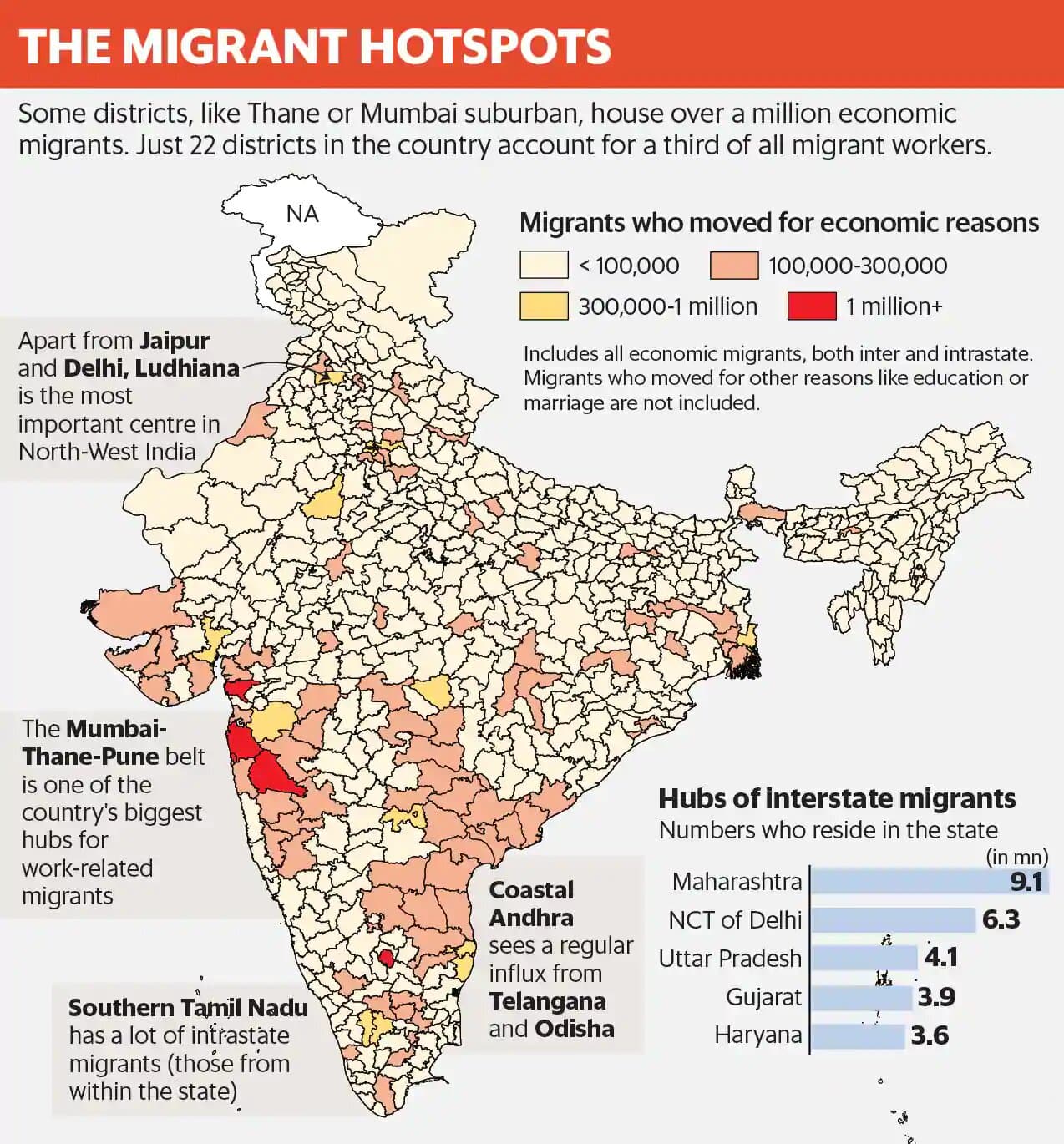Garib Kalyan Rojgar Abhiyan | 18 Jul 2020
This article is based on the article “Garib Kalyan Rojgar Abhiyan: Will the scheme be of help?” which was published in Financial Express on 15/07/2020. This article deals with the objectives and limitations of the recently launched Garib Kalyan Rojgar Abhiyan (GKRA).
The Covid-19 lockdown left million migrant labourers migrating across cities in inhuman and compelling conditions. Faced with lives and livelihood challenges, a large number of them began to leave in groups to their native places, many on foot; it was a human tragedy.
To alleviate their woes a number of relief measures were initiated by the State and Centre Government. A stimulus package to support the economy was announced. There were structural reforms covering agriculture, core sectors and MSME. Introduction of short-term relief measures for migrants, including free foodgrains for three months, employment under MGNREGA, one-time payment under Jan-Dhan and easy loans under Mudra Yojana to migrants at their native places.
In that series, recently a new package of 50,000 crore has been launched under Garib Kalyan Rojgar Abhiyan (GKRA). Nature of work offered under this scheme includes building gram panchayat bhawans, anganwadi centres, national highway works, railway works and water conservation projects.
This will provide immediate relief to families of migrant workers while creating infrastructure in rural areas, and help generate rural demand.
Benefits of Garib Kalyan Rojgar Abhiyan
- It will create livelihood opportunities for the returned migrants, and while doing so it is expected to create durable infrastructure in rural areas.
- For eg. Saturate villages with public infrastructure and create livelihood opportunities viz. Roads, Housing, Anganwadis, Panchayat Bhavans, various livelihood assets and Community Complexes among others.
- The basket of a wide variety of works will ensure that each migrant worker is able to get an opportunity of employment according to his skill, in the coming 125 days.
- The Program will also prepare for expansion and development of livelihoods over a longer term.
Multi Ministerial Initiative
- The Abhiyaan is a convergent effort between 12 different Ministries/Departments, namely; Rural Development, Panchayati Raj, Road Transport & Highways, Mines, Drinking Water & Sanitation, Environment, Railways, Petroleum & Natural Gas, New & Renewable Energy, Border Roads, Telecom and Agriculture, to expedite implementation of 25 public infrastructure works and works relating to augmentation of livelihood opportunities.
Implementing Authority
- The Ministry of Rural Development is the nodal Ministry for this campaign and the campaign will be implemented in close coordination with the State Governments.
- Central Nodal Officers of the rank of Joint Secretary and above will be appointed to oversee the effective and timely implementation of various schemes in the identified districts.
Coverage
- It would cover the ones who returned to 116 districts of six states—Bihar (32 districts), Uttar Pradesh (31), Madhya Pradesh (24), Rajasthan (22), Odisha (4) and Jharkhand (3). These 116 districts also include 27 aspirational districts as identified by the NITI Aayog..
Caveats In The Scheme
- Exclusion of States: It would be implemented only in 116 districts of six states, it is discriminatory in that states such as Chhattisgarh and West Bengal are outside its ambit.
- Inequitable Allocation: Odisha and Jharkhand with large migrant workers got less allocation in terms of the number of districts.
- Lack of Universal Coverage: this scheme will cover only two-thirds of migrant workers who have returned, and one-third fall outside its coverage.
- Lack of clarity in work allocation: Different stakeholders—ministries/departments, district administrations, banking systems—will coordinate on things such as timely payments to the workers. To that extent, the scheme will face implementation challenges.
Way forward
- Creating a Single IT platform: Bringing all the stakeholders on a single IT-based platform, especially when the government is facilitating the role of an aggregator.
- Universal Basic Income: Woes of distressed migrants could have been redressed by giving a basic income, or as the second-best the government could have made a reasonable amount of money transfer (Direct Benefit Transfer, or DBT).
- Creating a database of migrant workers: The government should seize this opportunity to build a database of migrant workers that could be used in the future to create a social security system for them.
Long Term Measures
- Creating a unified economy: Creating a unified economy where free movement of labour and capital should be allowed. States with older populations would require younger labour, which states with younger populations could supply.
- Establishing a Migration Commission: It should be given the mandate to prepare an appropriate social protection and welfare system for migrant workers.
- Strengthening existing schemes: Schemes like MGNREGA should be adequately funded to provide employment to migrants for at least the remaining months of this year.
Conclusion
The intent behind the Garib Kalyan Rojgar Yojana seems noble and a much needed one. However, the success of the program depends upon whether its benefits reach the migrant laborers in time and is able to revive rural demand as soon as possible.
|
Drishti Mains Question In the COVID-19 large numbers of returnee migrant workers continue to face livelihood issues and economic vagaries. Discuss the sufficiency of Central Government initiatives in providing the much needed relief. |
This editorial is based on “Europe can be a key ally for India” published in Hindustan Times on July 14th, 2020. Watch this on our Youtube channel now.

